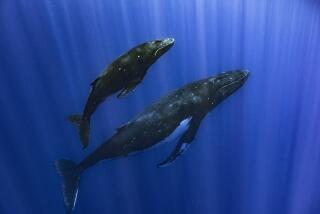An Ambitious New Look at the Language of Dolphins
- Share via
PALO ALTO — Ken Norris has been listening to dolphins for a long time, and he thinks the intelligent creatures have a lot to teach humans.
“It’s funny--whenever you talk about their human attributes, people’s ears perk up,” Norris said. “Everyone thinks, ‘What are they saying about us?’ ”
It’s not so much what they’re saying, but how they’re saying and thinking it that interests Norris, a biologist at the University of California, Santa Cruz.
After more than 30 years of working with dolphins, Norris has launched an ambitious study to learn how they communicate, think and perceive their watery world.
His subjects will be two Atlantic bottlenose dolphins, Josephine, 22, of San Diego and Gwendolyn, 18, of Hawaii, who arrived on campus in July after years of serving the Navy.
They will be joined later by six smaller recruits--Pacific white-sided dolphins from Monterey Bay--who will complete the school, giving the Santa Cruz scientists a large, diverse class of the cetaceans.
‘Break Down Barriers’
“It’s important to break down the barriers between us and other higher animals to help us diffuse our arrogance about the world,” Norris said in an interview at the U.C. Long Marine Laboratory, where he is director of cetacean research and professor of natural history.
“What’s going to be shown is that the difference is absolutely insensible . . . that there are more commonalities than differences between the higher marine mammals and Homo sapiens. “
When Norris, 62, started studying dolphins in 1953 as the first curator of Marineland on the Palos Verdes Peninsula, there was a “tremendous vacuum of knowledge about them,” he said.
So little was known that Norris was sent to the Pacific Ocean to find out if there were dolphins near Los Angeles, he said. His first experience trying to capture the mammals suggested they used more than their eyes to escape.
“We were trying to net those. . . animals and they were twice as smart as we were,” Norris said. “We began to realize they had an amazing sonar system.”
Built-in Sonar
In the years that followed, he worked with a captive dolphin named Cathy in tests that provided “the first unequivocal confirmation that the animals had sonar.”
“These dolphins put up with a lot of baloney sometimes,” Norris said. “Some of them are smart enough that when you get a dumb trainer who’s going too slowly, you can see a dolphin drumming his fingers and thinking, ‘Get on with it.’ ”
His early work on dolphin sonar was published in 1961. Subsequent studies found that dolphins emit clicking noises, at rates as high as 700 clicks a second, from the nasal passages inside their foreheads.
“As we fooled around with them, we realized that the animals could release a sound beam, like a flashlight beam, that was a very intense, highly directed beam of sound,” Norris said.
May Hear Through Jaws
The way the beam bounces off an object and returns as an echo helps the creatures identify boats, fish and other objects. It is Norris’ intent, working with other researchers and head trainer Kathy Krieger at Santa Cruz, to determine how dolphins emit and receive the sound.
It is Norris’ hypothesis that dolphins hear through their jaws, not their tiny pinhole-like ears. He also will try to prove that dolphins catch fish by disarming them with sound.
His theory is that dolphins zap prey with sound at an intense, low pitch calculated to make the fish “dotty with too much noise.”
Additional experiments will compare how dolphins use sight and sonar abilities to identify and recognize an object--to see if they can interchange acoustic and visual perceptions.
Perhaps the most intriguing research will be conducted by Norris and graduate student Carol Howard, a speech pathologist, who will study the way dolphins communicate.
Chorus of Dolphin Whistles
“How does a school of dolphins decide to go to sea?” Norris said. “They sit around and whistle at each other until they get a chorus going.”
Like a symphony of musicians warming up together, the dolphins will spend hours trying to “get their act together” so that they are so in tune they can swim out in the deeper water as a society that is in harmony, he said.
They have a repertoire of sounds for other situations. They may whistle and move in rhythm one way in courtship, and another way when they’re feeling threatened or aggressive.
“Cetaceans are remarkable, lovable beasts,” Norris said, as he watched them swim in their tank. “I don’t want people to live with the myth--the mythical beast that will take over New York City.
“The true animal is terribly much more interesting.”
‘We were trying to net those . . . animals and they were twice as smart as we were.’
More to Read
Sign up for Essential California
The most important California stories and recommendations in your inbox every morning.
You may occasionally receive promotional content from the Los Angeles Times.













